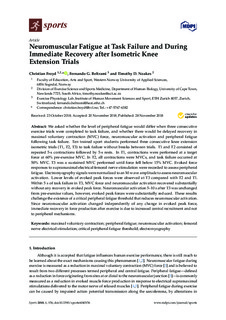| dc.contributor.author | Frøyd, Christian | |
| dc.contributor.author | Beltrami, Fernando G. | |
| dc.contributor.author | Noakes, Timothy D. | |
| dc.date.accessioned | 2019-02-13T14:48:16Z | |
| dc.date.available | 2019-02-13T14:48:16Z | |
| dc.date.created | 2019-01-15T13:11:28Z | |
| dc.date.issued | 2018 | |
| dc.identifier.citation | Froyd, C., Beltrami, F. & Noakes, T. (2018). Neuromuscular fatigue at task failure and during immediate recovery after isometric knee extension trials. Sports, 6(4). | nb_NO |
| dc.identifier.issn | 2075-4663 | |
| dc.identifier.uri | http://hdl.handle.net/11250/2585299 | |
| dc.description.abstract | We asked whether the level of peripheral fatigue would differ when three consecutive exercise trials were completed to task failure, and whether there would be delayed recovery in maximal voluntary contraction (MVC) force, neuromuscular activation and peripheral fatigue following task failure. Ten trained sport students performed three consecutive knee extension isometric trials (T1, T2, T3) to task failure without breaks between trials. T1 and T2 consisted of repeated 5-s contractions followed by 5-s rests. In T1, contractions were performed at a target force at 60% pre-exercise MVC. In T2, all contractions were MVCs, and task failure occurred at 50% MVC. T3 was a sustained MVC performed until force fell below 15% MVC. Evoked force responses to supramaximal electrical femoral nerve stimulation were recorded to assess peripheral fatigue. Electromyography signals were normalized to an M-wave amplitude to assess neuromuscular activation. Lower levels of evoked peak forces were observed at T3 compared with T2 and T1. Within 5 s of task failure in T3, MVC force and neuromuscular activation recovered substantially without any recovery in evoked peak force. Neuromuscular activation 5–10 s after T3 was unchanged from pre-exercise values, however, evoked peak forces were substantially reduced. These results challenge the existence of a critical peripheral fatigue threshold that reduces neuromuscular activation. Since neuromuscular activation changed independently of any change in evoked peak force, immediate recovery in force production after exercise is due to increased central recruitment and not to peripheral mechanisms. | nb_NO |
| dc.language.iso | eng | nb_NO |
| dc.publisher | MDPI | nb_NO |
| dc.rights | Navngivelse 4.0 Internasjonal | * |
| dc.rights.uri | http://creativecommons.org/licenses/by/4.0/deed.no | * |
| dc.subject | maximal voluntary contraction | nb_NO |
| dc.subject | peripheral fatigue | nb_NO |
| dc.subject | neuromuscular activation | nb_NO |
| dc.subject | femoral nerve electrical stimulation | nb_NO |
| dc.subject | critical peripheral fatigue threshold | nb_NO |
| dc.subject | electromyography | nb_NO |
| dc.title | Neuromuscular Fatigue at Task Failure and During Immediate Recovery after Isometric Knee Extension Trials | nb_NO |
| dc.type | Journal article | nb_NO |
| dc.type | Peer reviewed | nb_NO |
| dc.description.version | publishedVersion | nb_NO |
| dc.rights.holder | © 2018 by the authors. | nb_NO |
| dc.source.pagenumber | 1-15 | nb_NO |
| dc.source.volume | 6 | nb_NO |
| dc.source.journal | Sports | nb_NO |
| dc.source.issue | 4 | nb_NO |
| dc.identifier.doi | doi.org/10.3390/sports6040156 | |
| dc.identifier.cristin | 1657171 | |
| cristin.unitcode | 203,10,1,0 | |
| cristin.unitname | Institutt for idrett, kosthald og naturfag | |
| cristin.ispublished | true | |
| cristin.fulltext | original | |
| cristin.qualitycode | 1 | |

